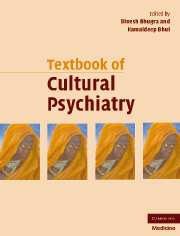Book contents
- Frontmatter
- Contents
- Contributors
- Foreword
- Preface
- Part I Theoretical background
- Part II Culture and mental health
- 8 Culture and psychopathology: general view
- 9 Developmental aspects of cultural psychiatry
- 10 Explanatory models in psychiatry
- 11 Culture-bound syndromes: a re-evaluation
- 12 Psychiatric epidemiology and its contributions to cultural psychiatry
- 13 Acculturation and identity
- 14 Cultural consonance
- Part III Culture and mental disorders
- Part IV Theoretical aspects of management
- Part V Management with special groups
- Part VI Cultural research and training
- Cultural psychiatry: the past and the future
- Index
- References
9 - Developmental aspects of cultural psychiatry
from Part II - Culture and mental health
Published online by Cambridge University Press: 11 August 2009
- Frontmatter
- Contents
- Contributors
- Foreword
- Preface
- Part I Theoretical background
- Part II Culture and mental health
- 8 Culture and psychopathology: general view
- 9 Developmental aspects of cultural psychiatry
- 10 Explanatory models in psychiatry
- 11 Culture-bound syndromes: a re-evaluation
- 12 Psychiatric epidemiology and its contributions to cultural psychiatry
- 13 Acculturation and identity
- 14 Cultural consonance
- Part III Culture and mental disorders
- Part IV Theoretical aspects of management
- Part V Management with special groups
- Part VI Cultural research and training
- Cultural psychiatry: the past and the future
- Index
- References
Summary
Ambrose Uchtenhagen, M.D., Ph.D., Professor of Social Psychiatry at the University of Zurich, Zurich, Switzerland, provided the original impetus to this historical analysis.
EDITORS' INTRODUCTION
The development of psychiatry as a discipline has moved from the observational to the social and, in the last few decades, to an increased emphasis on genetic and gene–environmental interactions in the causation of psychiatric disorders. The emphasis in cultural psychiatry varied between Western Europe and the USA. In Europe, often the social anthropologies followed the colonial masters in observing the natives and their rituals in their natural habitat. These led to misconceptions about diagnosis and a management of psychiatric cases but, more importantly, it meant that the traditional way of dealing with mentally ill individuals and mental illness were criticised, looked down upon and in some cases even destroyed. The traditions, however, survived perhaps of oral tradition of history and information being passed on across generations.
Westermeyer in this chapter sets out the global context within which cultural psychiatry has emerged and started to make its presence felt. He argues that cultural psychiatry has many features in common with social psychiatry in that both relate to social institutions such as family, community and psychiatric institutions. There are distinctions between the two types of psychiatry as well in that their focus is somewhat different. Illustrating the historical context by using migration as an example and the notions of racial and ethnic superiority/inferiority became more apparent. Current status of cultural psychiatry follows on from two different traditions – European and American.
- Type
- Chapter
- Information
- Textbook of Cultural Psychiatry , pp. 113 - 126Publisher: Cambridge University PressPrint publication year: 2007



